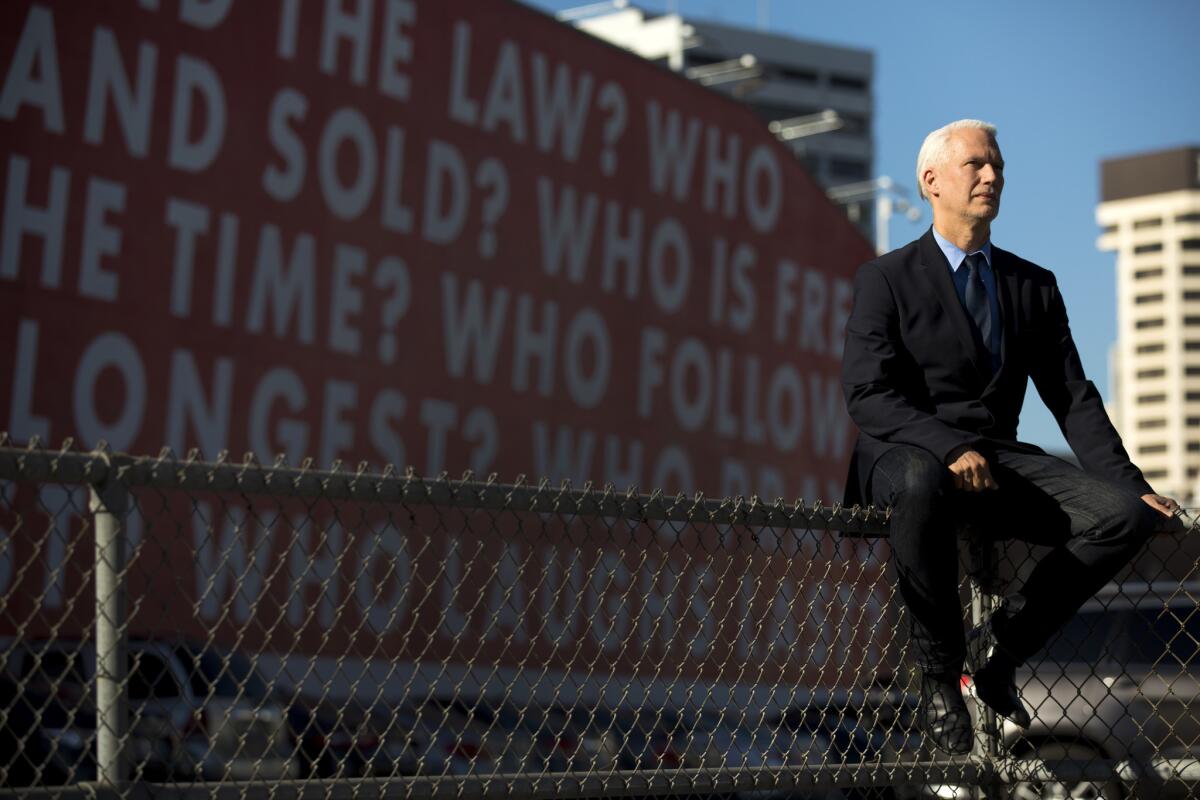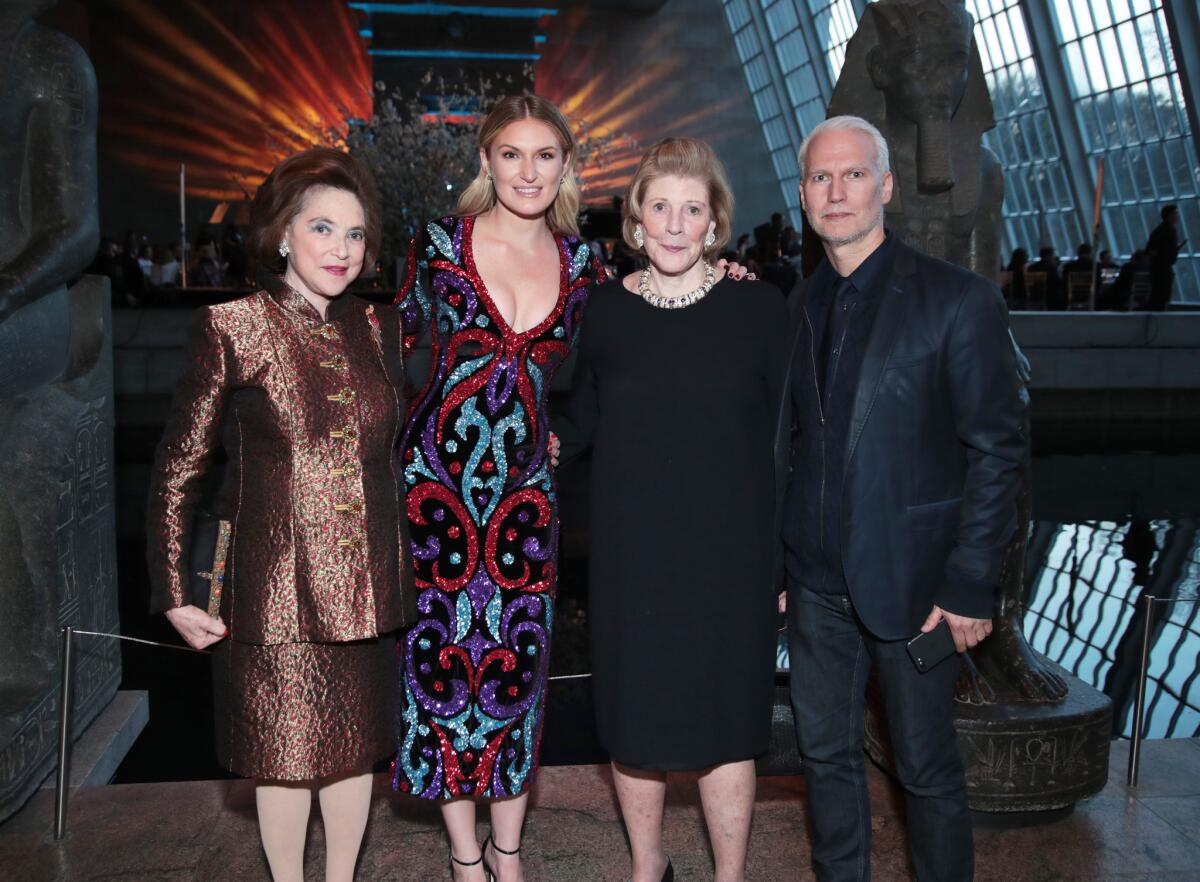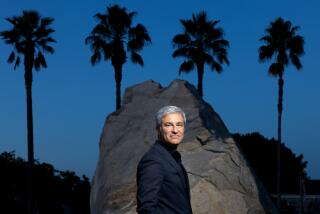New MOCA director Klaus Biesenbach embarks on a ‘civic-minded’ mission to steady the museum

It’s been just three weeks since Klaus Biesenbach took the reins at Los Angeles’ Museum of Contemporary Art, and the new director is still settling into his Grand Avenue office. It’s a spare space, with a modest conference table in the center and wrinkled maps of L.A. laid out on the plush, gray carpet — but little else. Biesenbach could have hung precious art from MOCA’s collection to decorate the room, but his freshly painted white walls are noticeably blank.
Instead, two large picture windows are flung wide open, each offering a square of sunlight and a patch of ever-shifting street life below, in MOCA’s courtyard. That’s the exhibition on view, as if pieces of moving, contemporary video art inside window frames.
“I open the window to understand,” says Biesenbach, 52, a native of West Germany. “I want, at any given time, to look at the museum and see how does it feel? Is it busy in the morning or in the afternoon? Is it actually shady enough, can people sit? I’m trying to experience it differently.”
Biesenbach is fascinated by urban views. In a sort of observational, new media art project he calls “#window23,” he has Instagrammed or Facebooked an iPhone snapshot of the view from his apartment window nearly every morning for 10 years. In Manhattan, where he lived for 23 years — working, most recently, as chief curator-at-large at the Museum of Modern Art and as director of its experimental satellite space, MoMA PS1 — his pictures captured soaring high rises and pedestrian-thick sidewalks. Now it’s palm trees and the Angels Flight Railway car inching up Bunker Hill outside his rental apartment overlooking Grand Central Market in downtown L.A.
The gesture is not insignificant. How a museum relates to its urban surroundings, its relationship to the city, is critically important to Biesenbach. A museum is meant not only to display art but to support artists and greater civic life, he says – which is central to Biesenbach’s mission for MOCA. “To be a resident amongst residents,” as he puts it. That could mean hosting voter registration initiatives at MOCA, expanding educational programming or simply adding better signage and a new, Metro-adjacent entrance at its Geffen Contemporary location to make the space more accessible.
“As a museum, you have a civic responsibility, you have a role in society, you have to be courageous, you have to open up your doors to allow for dialogue,” he says.
I follow one very important principle in decision-making: It’s not about you; it’s about the difference you can make.
— Klaus Biesenbach
Biesenbach, the sixth director in MOCA’s nearly 40-year history, has taken on a museum in turmoil. In March, previous director Philippe Vergne fired the museum’s highly respected chief curator, Helen Molesworth, before departing himself in May, four years into his five-year contract. MOCA also canceled its annual gala this spring, its biggest fundraiser, due to a controversy over lack of diversity among former gala honorees, all of whom had been straight white men. Around the same time, artist board member Lari Pittman, who is gay and Latino, resigned, citing diversity issues as well as a fractured vision among the board, the directorship and the curatorial team.
All after internal drama, including leadership changes and financial difficulties, since the mid-2000s. The museum’s endowment is now more than $134 million.
“Yes, we’ve gone through crisis,” artist board member Catherine Opie says. “But we also have shown an incredible will to make the institution continue with an enormous amount of support from the trustees.”
Biesenbach says he wasn’t deterred by the state of affairs at MOCA. He proceeded cautiously after receiving a call in June from Opie, gathering information from more than 30 board members and other museum stakeholders. Several people told him the MOCA directorship would be “the most difficult, if not the most impossible, job in the art world,” he says. “But after 10 years of working for and with [MoMA PS1 board chair] Agnes Gund, I follow one very important principle in decision-making: ‘It’s not about you, it’s about the difference you can make.’”
Ultimately, he was drawn by the possibilities at MOCA, which he describes as “MoMA and MoMA PS1 in one,” referring to the properly lit, climate-controlled Grand Avenue museum and the vast, more pliable and experimental Geffen space. “What Klaus will bring is the ingenuity of what he did at PS1. Nobody thought this museum in Queens would rise to the position that it did,” Opie says. “I feel he’ll bring an enormous amount of energy as well as support for the roots of MOCA being an artists’ museum.”
He was also inspired by the museum’s new board leadership – two women – chair Maria Seferian and president Carolyn Powers. “I think MOCA, with this history, with this collection, with this board we have at the moment, with the endowment we have – it’s a huge opportunity,” Biesenbach says.
A primary goal now is “alignment,” he says. “To develop a vision for the museum and then align the board and the staff and all the other constituencies. And vision doesn’t necessarily mean huge buildings or blockbusters. It could also be a much more modest vision: simply functioning.
“I think contemporary art changes how you look at the world,” he adds. “And that’s huge for everybody who comes into the situation.”
Biesenbach admits that MOCA’s collection and exhibition programming could better reflect the diversity of L.A., particularly the Asian and Chicano communities. A chief goal is “a multiplicity of voices,” he says. “At MoMA PS1 I brought in under-represented and under-recognized art forms, like media and performance, and under-represented or under-recognized artists, like Reza Abdoh or Carolee Schneemann. So that’s something I see as a mission at MOCA.”
To critics who have griped that Biesenbach is another white, European male director, he responds seriously : “I never understood myself as being part of a majority,” he says, “and I don’t think I act like it.”
He’s hesitant to elaborate, not wanting to be exploitative, he says. But when pressed, he adds: “I think in my generation, growing up queer, I was not part of the majority. Being out was a challenge to many. It was not being included, and it also meant growing up with the fear of AIDS, of dying — and in the eyes of many who didn’t understand at the time — that meant adding insult to injury, dying in shame.”

I think contemporary art changes how you look at the world. And that’s huge for everybody who comes into the situation.
— Klaus Biesenbach
Growing up near Cologne, Biesenbach was not an artist nor were his parents. His love affair with art began early and intensely, though, in primary school. His art teacher had studied with the artist Joseph Beuys and passionately dispersed his philosophies. “Art as responsibility, art as a civic engagement, art has to be a force in society, art has to be courageous, unafraid, ecological, ecological. That was Joseph Beuys talking to my art teacher. We were like 8 or 9 years old!”
In 1989, Biesenbach spent the summer in New York — “I thought I’d found my city,” he says — but then the Berlin wall fell and he was drawn back to Germany, intrigued by the changing political, social and cultural landscape. As an intern for the East German government, in 1991 he turned a vacant former margarine factory into what’s now a leading alternative contemporary art space, Berlin’s Kunst-Werke Institute for Contemporary Art. He featured international artists, performers and writers such as Félix González-Torres, Yoko Ono, Susan Sontag and fashion designer Hedi Slimane. In 1996, he established the Berlin Biennale, securing the city’s reputation as an international art hub.
He relocated to New York in 1995, bringing his experimental, cross-disciplinary sensibility to P.S.1 Contemporary Art Center, before it was affiliated with MoMA. In 2004, he joined MoMA with a concurrent role at MoMA PS1, where he took over as director in 2010.
As a museum, you have a civic responsibility, you have a role in society, you have to be courageous, you have to open up your doors to allow for dialogue.
— Klaus Biesenbach
In an effort to spark dialogue between MOCA and his new hometown, one of the first things Biesenbach did in L.A. was resurrect Barbara Kruger’s mural, “Untitled (Questions),” at the Geffen. It poses screaming, provocative questions to passersby in red, white and blue, addressing gender, race and power.
Going forward, he’d like to show more emerging artists at MOCA, he says. “And I want to be as local as international.”
Like his blank office walls, Biesenbach says he’s keeping an open mind about the museum’s needs. He’s in a “listening and learning” phase, speaking at length to current and former museum staffers, board members, artists and others in the city.
Will he beef up the curatorial staff, which has been whittled down to one senior curator, Bennett Simpson, two associate curators and an assistant curator? Or fill Molesworth’s position? That remains to be seen, Biesenbach says, somewhat evasively. “I think it wouldn’t be responsible to walk in here and say ‘Oh, I know how the world functions’ because I think if I didn’t listen to everybody and give it some time, I wouldn’t be doing due diligence.”
He envisions changes to the Geffen on the horizon — he’d like to make the space “more accessible, more porous” and possibly turn part of the building into a cafe and event space that wouldn’t close between exhibitions.
He says he’s considering — but not committing to — free admission, like the Broad across the street and Westwood’s Hammer Museum. MOCA’s $15 general admission amounted to an average of $800,000 annually between 2014 and 2016, tax filings show. But Biesenbach says free admission would mean a bigger loss for the museum, factoring in costs due to increased attendance and an estimated loss in membership revenue. “Unfortunately, it would cost the museum about $2 million a year to not take admission,” he says. “So that’s not an easy one.”
One thing Biesenbach is clear about in his role as director: he won’t be organizing exhibitions, as his predecessor occasionally did. He sees his role at MOCA as strictly administrative, focused on fundraising and growing the museum’s attendance, programming, endowment and board. At MoMa PS1 he tripled the annual budget to $12 million and grew the board from 11 to 30. At MOCA he’s already taken control of the museum’s gala, which in recent years has been the sole purview of the board co-chairs. “I love fundraising,” he says.
On Monday, MOCA will announce five new board members who range in age from their 30s to 70s. They also represent four continents: Dr. Adrian Cheng from Hong Kong, China; Simon Mordant from Sydney, Australia; Julia Stoschek from Berlin; Marina Kellen French from New York; and Sean Parker from L.A.
Meantime, Biesenbach’s period of listening and learning includes wandering L.A. on foot, as well as by Metro and bus.
Will Biesenbach eventually fill his blank office walls?
“No,” he says bluntly. Then he glances out his office window, surveying the street life below.
“Well,” he adds, “maybe I’ll put up a map. But no pictures.”
ALSO
Review: Helen Molesworth’s final show at MOCA is the anti-celebrity show we need right now
A to-do list for MOCA’s new director, Klaus Biesenbach
Follow me on Twitter: @debvankin
More to Read
The biggest entertainment stories
Get our big stories about Hollywood, film, television, music, arts, culture and more right in your inbox as soon as they publish.
You may occasionally receive promotional content from the Los Angeles Times.











